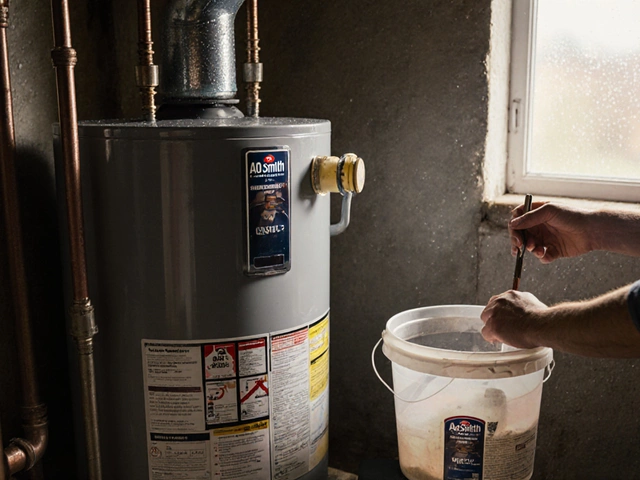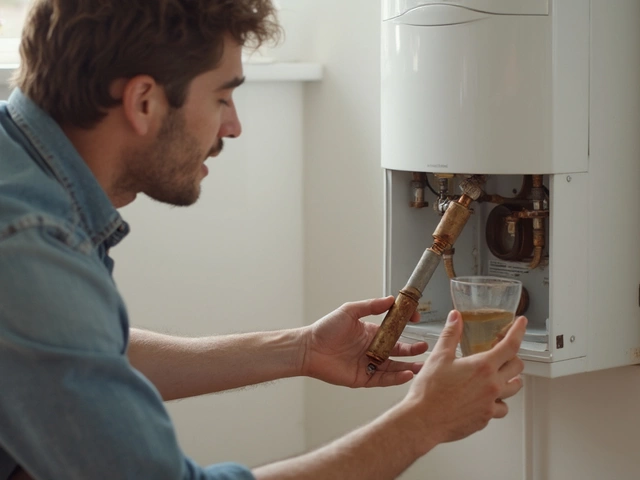Ever wondered why your water heater needs that mysterious metal rod inside? That's the anode rod, and it's there to help your tank last as long as it can. It fights rust like a champ but doesn't live forever. If the idea of your trusty water heater suddenly failing gives you the chills, knowing how and when to replace this rod can help you avoid cold showers.
The cost of replacing an anode rod isn't as scary as it sounds. On average, the rod itself costs between $20 and $50. But if you decide to hire a professional for the job, labor might bring the total to around $150 to $300. Remember, this isn't something you want to skip because replacing the whole heater is a lot more expensive.
- Understanding Anode Rod Function
- Cost Breakdown of Replacement
- DIY vs. Professional Replacement
- Tips for Anode Rod Maintenance
Understanding Anode Rod Function
Your water heater’s life depends on an unsung hero: the anode rod. So, what’s the deal with this underrated component? It’s actually a metal rod, usually made from magnesium, aluminum, or zinc, and it’s purposely designed to get corroded. You'd think corrosion is bad, but in this context, it’s the rod taking one for the team—acting as a sacrificial component to keep the rest of your tank rust-free.
Why is this important, you ask? Consider it the bodyguard against rust. When water interacts with metal, corrosion’s inevitable. However, the anode rod corrodes faster than your tank due to something called electrolysis. This process protects your tank by eating up rust-inducing elements before they reach the tank walls.
The Science Bit
Corrosion occurs because of different metal potentials. The anode rod is less resistant to corrosion than the tank itself, so the water attacks it first. This is why it’s known as a “sacrificial” rod. When it deteriorates, it’s time to replace it—do this and keep your tank healthy.
| Material | Lifespan |
|---|---|
| Magnesium | 3-5 years |
| Aluminum | 5-7 years |
| Zinc | 5-7 years |
And there you have it, in a nutshell: the humble anode rod quietly working its magic, so your heater doesn’t become a giant rust bucket. Regular checks every couple of years will help you catch it before it’s completely gone. It's not a glamorous job, but it sure is a critical one.
Cost Breakdown of Replacement
When it comes to replacing your anode rod, the costs aren't just about the rod itself. There's a bit more to consider, so let’s break it down.
Cost of the Anode Rod
The anode rod itself usually ranges from $20 to $50. This depends on the type of metal it’s made from. Magnesium rods usually cost more than aluminum ones, but they're also more effective at protecting your tank.
DIY Replacement Costs
If you're handy and decide to replace the rod yourself, you'll just need a few basic tools like a wrench. Most people already have these lying around, but if you need to buy them, it won't set you back more than $10 to $30.
- Wrench: $10-$30 (if you don’t own one)
- Time: around 1-2 hours
Professional Replacement Costs
Hiring a pro can add to the expense but saves you time and effort. Professional labor costs can vary widely depending on where you live, but you’re looking at roughly $150 to $300 total for the job, including the part.
Tip: Regularly replacing the anode rod can extend the life of your water heater, saving you from much bigger bills down the line.
Extra Costs to Consider
Sometimes, anode rods are tricky to remove due to corrosion or awkward positioning. If a professional needs extra time or tools to get the job done, it might add a little extra to your bill.
| Cost Component | Price Range |
|---|---|
| Anode Rod | $20 - $50 |
| DIY Tools | $10 - $30 |
| Professional Labor | $100 - $250 |
Considering these costs can help you budget for this essential maintenance task, whether you tackle it yourself or call in the pros.

DIY vs. Professional Replacement
Choosing between doing a DIY anode rod replacement or calling a pro can feel like a big decision. Each option has its perks and pitfalls. Let's break it down so you can make an informed choice.
The DIY Route
Going the DIY route can save you some cash. If you’re handy with tools and enjoy a weekend project, this might be up your alley. Here's what you'll need:
- A replacement anode rod
- Pliers or a wrench for loosening the old rod
- Pipe tape for a secure fit
- A step stool, if your heater is in a tight spot
The process is straightforward but requires caution. Drain a bit of water from the heater, unscrew the old rod, and replace it with the new one. Easy, right? But remember, the tank holds hot water that's under pressure, so be careful!
Calling in the Professionals
If you’re less comfortable tinkering with plumbing, hiring a professional is the way to go. A skilled technician can do the job in about an hour. Although this might cost you $150 to $300, it’s a small price to pay for peace of mind and the assurance that everything’s done right.
Pros know the warning signs, like too much rust or corrosion, that might mean it's time for a full water heater check-up, not just an anode rod replacement.
Here's a quick comparison to help decide what's best for you:
| DIY | Professional |
|---|---|
| Lower cost (around $20-$50) | Higher cost ($150-$300) |
| Requires basic tools | No tools needed on your part |
| Learn something new | Gain expert advice |
| Potential for error | Greater reliability |
Whichever path you take, regular replacement of that anode rod is key to keeping your water heater in top shape. So, weigh the pros and cons, and choose what's comfortable for you. Happy heating!
Tips for Anode Rod Maintenance
Keeping your water heater happy is easier than you might think, especially with the right maintenance for the anode rod. Here’s how you can ensure it does its job for as long as possible.
Regular Inspection
First off, check that rod regularly. Experts suggest every 1 to 3 years, depending on your water quality. Soft water tends to eat through the anode rod faster, so if that's your case, aim for the shorter end of that range. Peek at the rod’s condition and see if it’s getting down to about half an inch thick or is coated with calcium.
Replace Before It's Too Late
Don’t wait until the rod’s totally gone to replace it. A new rod is much cheaper than a new water heater. If it’s severely corroded, swap it out to keep things in check.
Material Matters
- Magnesium Rods: These are great for softer water but might wear out quicker.
- Aluminum/Zinc Rods: If you have harsh water, these can last longer and help reduce that rotten egg smell from sulfur.
Easy on the Tank
When replacing or checking the rod, make sure to gently loosen it and avoid damage to the tank lining. A little care goes a long way.
Keep Your Tools Handy
A 1 1/16-inch socket and a breaker bar or a cheater pipe can make the job smoother if you’re doing it yourself. Remember, safety first—turn off the power and water before diving in.




